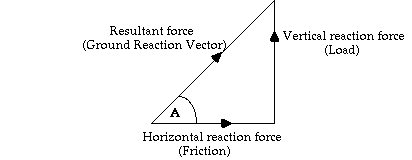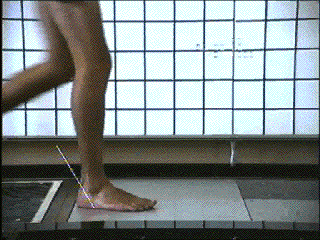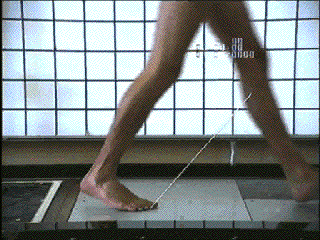Ground Reaction Vector
Shear (friction) forces
-
horizontal force component
-
caused by friction
-
generate forward-backward (antero-posterior) accelerations:
FAP = m.(aAP)
-
backwards (-) during early stance (loading): body is decelerating
-
forwards (+) in late stance (push-off): body is decelerating
Resolution of Forces
-
combine two forces (load and shear)
-
parallelogram or triangle of forces
-
resultant (the GRV) is longer than each of the components
-
slopes at an angle depending on shear


tan A = opposite / adjacent = Load / Shear
by pythagoras: total force (resultant) = Ö(Load2
+ Shear2)
-
body accelerates up and down
-
accelerations add to and subtract from the body weight:
F = m.g
F = m.(g + a)

-
load rises from zero at heel-strike
-
increases to slightly more (about 20%) than body weight in
early stance
-
falls to less than body weight during mid-stance (30% cycle)
-
at toe-off (push-off phase) it rises above body weight
 Estimating
Muscle Activity from the GRV
Estimating
Muscle Activity from the GRV
same rule applies as in standing:
-
external moment due to GRV = internal Moment due to muscle
-
active muscle is on opposite side of joint to GRV
-
GRV on extensor side of the joint => flexor muscle
active
-
GRV on flexor side of the joint => extensor muscle
active
-
muscle (or ligament) moment = size of GRV x lever arm lever
arm (perpendicular distance between the GRV and joint)


dorsiflexors + quads plantarflexors
+ posterior capsule
Center of Pressure

-
starts at the lateral border of the heel at initial contact
-
moves forward through stance to big toe (hallux) at toe-off
-
CoP velocity not constant - moves quickly over heel and toes


 Plantar
pressure measurement (pedobarography)
Plantar
pressure measurement (pedobarography)


Hennig,
E. M., & Milani, T. L. (1995). In-shoe pressure distribution for running
in various types of footwear. Journal of Applied Biomechanics, 11(3), 299-310.
Abnormal pressures
Flat foot (everted, pronated)

Cavus foot (inverted, supinated)


Equinus (tiptoe)
Calcaneal (on heels)
 Estimating
Muscle Activity from the GRV
Estimating
Muscle Activity from the GRV


 Estimating
Muscle Activity from the GRV
Estimating
Muscle Activity from the GRV




 Plantar
pressure measurement (pedobarography)
Plantar
pressure measurement (pedobarography)

